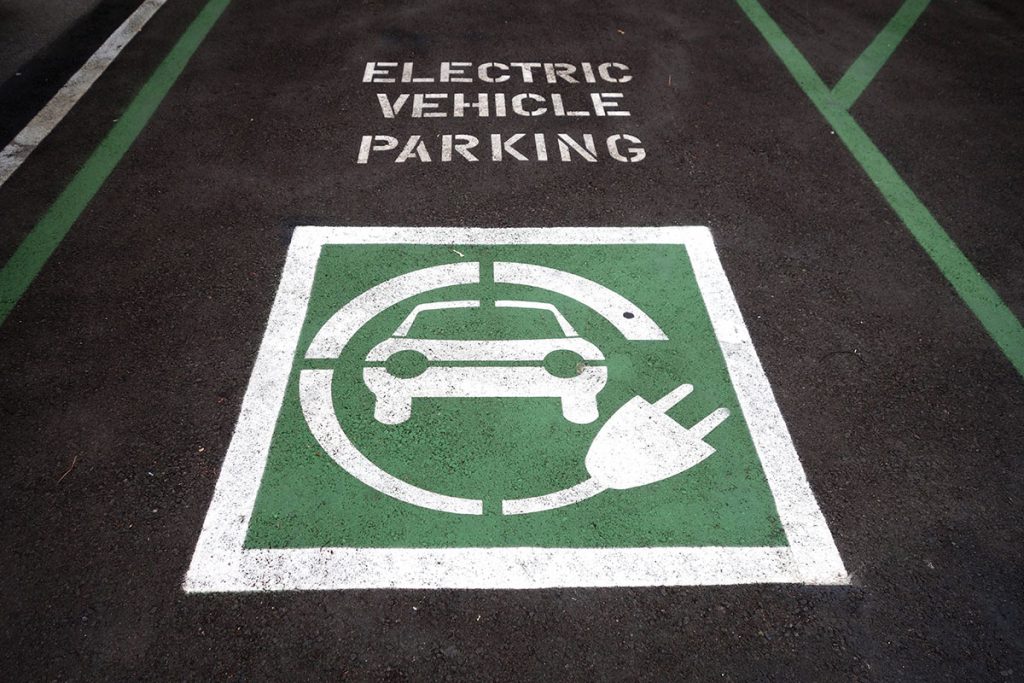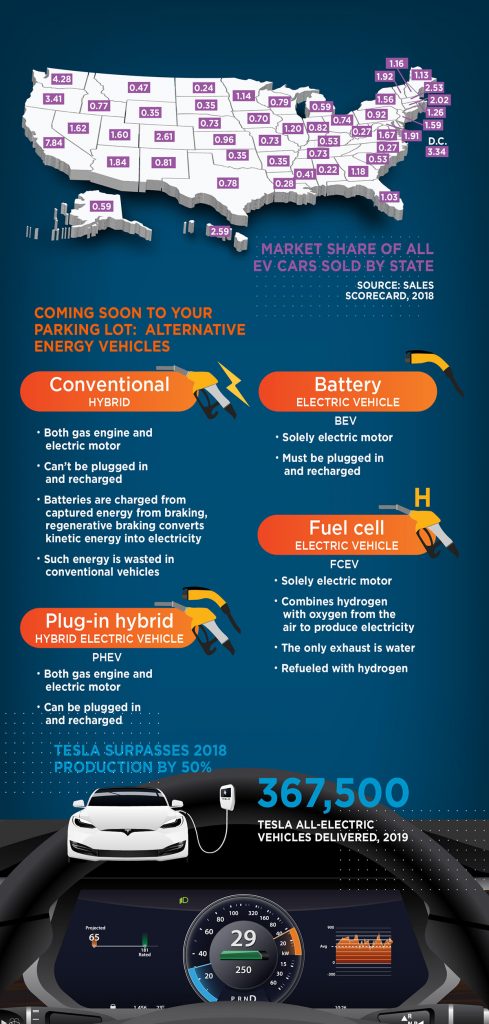Greening of the parking lot
Website EVAdoption reports that in 2018, plug-in electrical vehicles (EVs) made up about 2 percent of total light vehicle sales nationally. In California, it was nearly 8 percent. Indeed, the 153,000 plug-in electric vehicles sold in California represent almost half of national electric vehicle sales. New York, Florida, Washington and Texas all saw plug-in electric vehicles sales exceed 10,000 units in 2018.
Apartment owners in states with high rates of adoption of electric vehicles will find themselves at a significant disadvantage in competing for the relatively affluent cohort of renters who own EVs if they do not accommodate their need to recharge those cars.
It’s all about power
There are several types of EV chargers on the market. Level 1 EV chargers plug into a standard 120 VAC, 15 or 20 Amp wall outlet. These chargers operate at a relatively low power level and are suitable for overnight recharging of an EV. A Level 1 charger is often included with the purchase of an EV.
Level 2 EV chargers plug into a 230 VAC, 30 Amp or higher wall outlet. These outlets are similar to what would be used for an electric clothes dryer. Since they provide both twice the voltage and twice the current of a 120 V wall outlet, Level 2 chargers can recharge an EV much more quickly than can Level 1 chargers.
The fastest EV chargers, such as the Tesla Supercharger, deliver high direct current power to the EV. Because they operate at very high power levels, these chargers may require specialized wiring to connect them to the AC supply. However, Tesla says that their Supercharger can recharge a Tesla car in 30 minutes.
Meeting the need
The simplest way to deliver charging capability to residents with EVs is to provide parking spaces with wall outlets. Because this solution would require overnight connection to recharge the vehicle, each parking space would likely be assigned to a particular resident. Residents could be charged a premium for these spaces in order to recover the cost of installing the wiring. Submeters could be used to track the power used and the cost of this power could be billed to the resident along with his other utility charges.
An issue with this approach is that it does not include load balancing. When an EV with a depleted battery is first plugged into a charging system, the amount of current drawn from the power system is very high. As the batteries in the EV approach full charge, the charging current is reduced in order to prevent overcharging, which can damage the batteries. Therefore, if many EV drivers get home from work at nearly the same time and plug in their EVs in order to charge them up for the next day, the total initial charging current drawn by all of the EVs may strain the capacity of the electrical system to support it.
An alternative approach is to install Level 2 chargers in the parking area. Level 2 chargers intended for the multifamily/commercial market have networking capabilities and will coordinate with each other to balance the load on the system. That is, they will seek to provide power to all of the EVs being charged without overburdening the power system. This allows the property to support charging more EVs at a time for a given wiring infrastructure.
A property with Level 2 chargers installed could use them with dedicated parking spaces assigned to individual residents as in the first scenario. However, because Level 2 chargers can recharge an EV more rapidly than Level 1 chargers, Level 2 chargers can also be used as a shared resource.
Providing EV chargers as a shared resource can reduce the capital expense to the property owner since fewer charging stations would be necessary to service a given number of EVs.
Sharing, however, introduces complications. Suppliers of Level 2 chargers for multifamily properties address these complications through their supplied apps and through their supported pricing models.
For example, the charging system app can be used to find out if a charger is currently available and to sign up on a waiting list if one is not. A notice is sent to a resident on the waiting list when a charger becomes available. Pricing can be set up to charge for both charging time and for time the EV is connected to the charger after it is fully charged. The latter charge is imposed to encourage residents to remove their vehicle from the charger once it is charged so that others may take their turn.
Pricing it out
Of course, there is a cost to the flexibility provided by Level 2 chargers. While a Level 2 charger intended for the home market may sell for around $500, commercial grade Level 2 chargers with networking capability may cost between $1,000 and $1,500 each. Their cost is in addition to the cost of running new electrical wiring to the parking area, which may be in the same range as the cost of the chargers.
The cost of the electrical changes depends on the distance of the parking spaces from the power panel, whether trenching or other costly construction methods are required to install the new wiring and whether electrical service upgrades are necessary. Therefore, it can vary significantly.
In addition to the cost of the equipment, electrical system changes and electricity costs, the suppliers of the charging equipment charge periodic service fees for managing the residents’ accounts and for maintaining the charging equipment. Residents with dedicated chargers may pay a fee directly to the equipment supplier while properties using the shared charger business model may be responsible for payment of service fee. The property manager would recover the service fee from the residents using the system by charging an access fee.
A final consideration
The Holy Grail of EV charging is to get the recharge time down to 15 minutes. If this happens, recharging an EV may become more like filling up a gasoline powered vehicle and “filling stations” may come to dominate the recharging landscape.
Currently, suppliers of high-speed EV charging stations are focusing on installing them at shopping centers or other venues where the driver will be otherwise occupied while his car is being charged, making the wait time less onerous.
While it would be hard to beat the convenience of plugging your car in when you get home and never having to worry about finding a charging station when you need it, as the availability of high speed chargers improves, the premium residents are willing to pay for that convenience is likely to decrease. Property managers should keep that in mind when deciding whether to introduce EV charging as an amenity at their properties and when deciding how to price it.
Historical perspective
- March 2024
- February 2023
- July 2022
- March 2022
- June 2021
- February 2021
- August 2020
- February 2020
- July 2019
- April 2019
- June 2018
- April 2018
- October 2017
- May 2017
- November 2016
- June 2016
- November 2015
- June 2015
- September 2014
- June 2014
- April 2014
- December 2013
- July 2013
- December 2012
- July 2012
- October 2011




